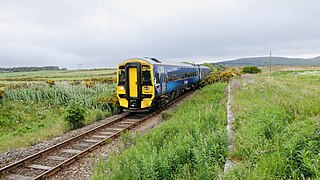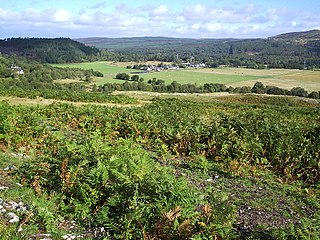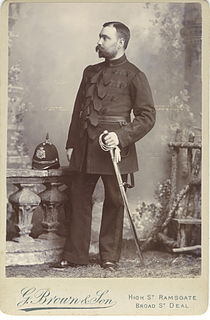
Strath of Kildonan, also known as Strath Ullie, (Scottish Gaelic : Srath Ilidh), is a strath in Sutherland, in the north of Scotland. It extends in a north-westerly direction from Helmsdale towards Kinbrace.

Strath of Kildonan, also known as Strath Ullie, (Scottish Gaelic : Srath Ilidh), is a strath in Sutherland, in the north of Scotland. It extends in a north-westerly direction from Helmsdale towards Kinbrace.
In 1813, during the Highland Clearances, a group of 50-60 men planned an ambush from the settlement of Suisgill in the Strath of Kildonan against a number of men who were employed by the Sutherland Estate in evicting tenants to make way for sheep farming. The estate men who were on horseback were tipped off in advance but were still pursued by the 50-60 men on foot, who as historian James Hunter described, had acted "just as their ancestors had done when launching one of the charges characteristic of clan warfare". Although the men on horse back escaped, another small group who were employed by the Sutherland Estate to carry out evictions as part of the Highland Clearances were caught in the Strath of Kildonan and surrounded by a mob of about 100 people. These Sutherland Estate employees were mostly shepherds and were permitted to leave as long as they did not return and their leader was told not show his face in the Strath of Kildonan again. [1]
In 1869, gold was found in the Strath and was exploited by local crofters and outside prospectors until the enterprise became unprofitable. A following depression in the local economy caused crofters to resume gold digging, which by 1886 brought them into conflict with the Sutherland Estates.
The River Helmsdale (also known as River Ullie) flows down the strath and into the sea at Helmsdale.
The A897 road runs along the strath, as does the Far North Line, with Kildonan railway station halfway along. [2] [3]

Sutherland is a historic county, registration county and lieutenancy area in the Highlands of Scotland. Its county town is Dornoch. Sutherland borders Caithness and Moray Firth to the east, Ross-shire and Cromartyshire to the south and the Atlantic to the north and west. Like its southern neighbour Ross-shire, Sutherland has some of the most dramatic scenery in the whole of Europe, especially on its western fringe where the mountains meet the sea. These include high sea cliffs, and very old mountains composed of Precambrian and Cambrian rocks.

Helmsdale is a village on the east coast of Sutherland, in the Highland council area of Scotland. The modern village was planned in 1814 to resettle communities that had been removed from the surrounding straths as part of the Highland Clearances.

The Far North Line is a rural railway line entirely within the Highland area of Scotland, extending from Inverness to Thurso and Wick. As the name suggests, it is the northernmost railway in the United Kingdom. The line is entirely single-track, with only crossing loops at some intermediate stations allowing trains to pass each other. In common with other railway lines in the Highlands and northern Lowlands, it is not electrified and all trains are diesel-powered.

The A897 single track road is entirely within the Highland council area of Scotland. It runs generally north from the A9 at Helmsdale to the A836 near Halladale Bridge, east of Melvich. The road passes through or near Kildonan, Kinbrace and Forsinard, and has a junction with the B871 at Kinbrace. It also passes through Achiemore.
In Scotland a factor is a person or firm charged with superintending or managing properties and estates—sometimes where the owner or landlord is unable to or uninterested in attending to such details personally, or in tenements in which several owners of individual flats contribute to the factoring of communal areas.

Strathnaver or Strath Naver is the fertile strath of the River Naver, a famous salmon river that flows from Loch Naver to the north coast of Scotland. The term has a broader use as the name of an ancient province also known as the Mackay Country, once controlled by the Clan Mackay and extending over most of northwest Sutherland.

Kinbrace railway station is a railway station serving the village of Kinbrace in the Highland council area in the north of Scotland. It is located on the Far North Line, 118 miles 20 chains from Inverness, between Kildonan and Forsinard. The station is managed by ScotRail, who operate the services at the station.

Elizabeth Sutherland Leveson-Gower, Duchess of Sutherland, also suo jure19th Countess of Sutherland, was a Scottish peer from the Leveson-Gower family, best remembered for her involvement in the Highland Clearances.
The Sutherland and Caithness Railway was a Scottish railway company that built a line from Helmsdale, the terminus of the Duke of Sutherland's Railway to Wick and Thurso in Caithness, giving the northern towns access to Inverness. It was driven through by the efforts of the 3rd Duke of Sutherland and the engineer Joseph Mitchell in the face of apathy from interests in Wick.

Culrain is a small village in Sutherland, Highland, Scotland.

Melvich is a village in the county of Sutherland on the north coast of Scotland. It is situated on the A836 road, near the mouth of the River Halladale. It has a successful Gaelic choir. The A897 road which runs from Helmsdale, through the Strath of Kildonan and past Kinbrace, terminates at Melvich.
Angus Sutherland CB was a Scottish Liberal politician.

Roderick Ross CVO CBE KPM was Chief Constable of Edinburgh City Police from 1900 to 1935.

Achrimsdale is a village in Highland, Scotland.

The Highland Clearances were the evictions of a significant number of tenants in the Scottish Highlands and Islands, mostly from 1750 to 1860.
West Helmsdale is a small settlement lying on the right bank of the River Helmsdale, on the east coast of Sutherland, Scottish Highlands and is in the Scottish council area of Highland. The village of Helmsdale lies on the left bank of the River Helmsdale.
Kilphedir is a small remote settlement, which sits in the Strath Ullie valley in Helmsdale, Sutherland, east coast of the Scottish Highlands and is in the Scottish council area of Highland.

Badbea is a former clearance village perched on the steep slopes above the cliff tops of Berriedale on the east coast of Caithness, Scotland. Situated around 5 miles (8 km) north of Helmsdale, the village was settled in the 18th and 19th centuries by families evicted from their homes when the straths of Langwell, Ousdale and Berriedale were cleared for the establishment of sheep farms. The last resident left the village in 1911 and a monument was erected by the son of former inhabitant, Alexander Robert Sutherland, who had emigrated to New Zealand in 1839. Today, the ruins of the village are preserved as a tourist attraction and memorial to the Highland Clearances.

The River Helmsdale is one of the major east-flowing rivers of Sutherland in the Highlands of Scotland. It flows broadly southeastwards from Loch Badanloch down the Strath of Kildonan, gathering the waters of the Bannock Burn on its left and the Abhainn na Frithe on its right before discharging into the Moray Firth on the North Sea at the town of Helmsdale. Other significant tributaries of the Helmsdale include the left-bank Suisgill Burn and the right-bank Craggie Water. Loch Achnamoine which is just over 1 km in length, lies on the line of the river 1 mi / 1.5 km downstream of Loch Badanloch. Loch Badanloch is one of a complex of three interconnecting lochs - the other two being Loch nan Clàr and Loch Rimsdale which gather waters from the moors on the southern edge of the Flow Country via the Allt an Lòin Tharsuinn, Allt Lòn a' Chùil and Rimsdale Burn.

The Kildonan Gold Rush was a gold rush in the Strath of Kildonan, Sutherland, in the Highlands of Scotland in 1869. Small amounts of gold had long been discovered in the Kildonan area. A nugget with enough material for a ring was discovered in 1818. Public interest was sparked, and a gold rush started, following a newspaper announcement in 1868 of the results of Robert Nelson Gilchrist more systematic search for gold. The gold rush proper began in January 1869. At this stage those searching for gold stayed in Helmsdale or more ad hoc accommodation near the Kildonan burn including the old Kildonan Church.
Coordinates: 58°09′22″N3°50′42″W / 58.156°N 3.845°W